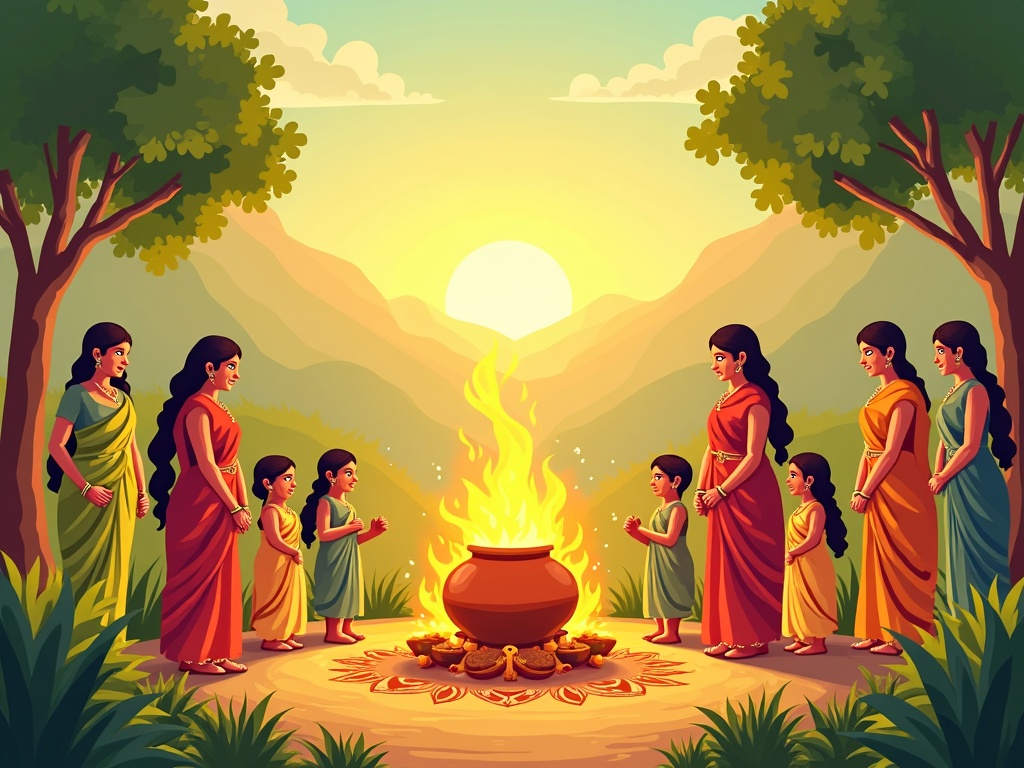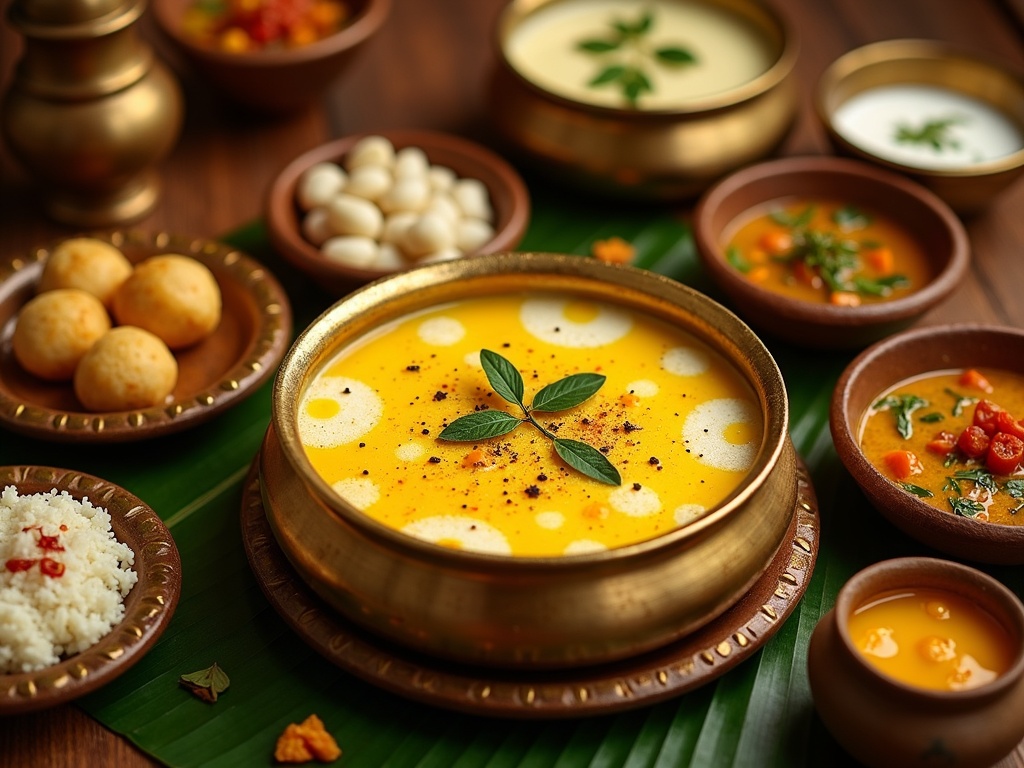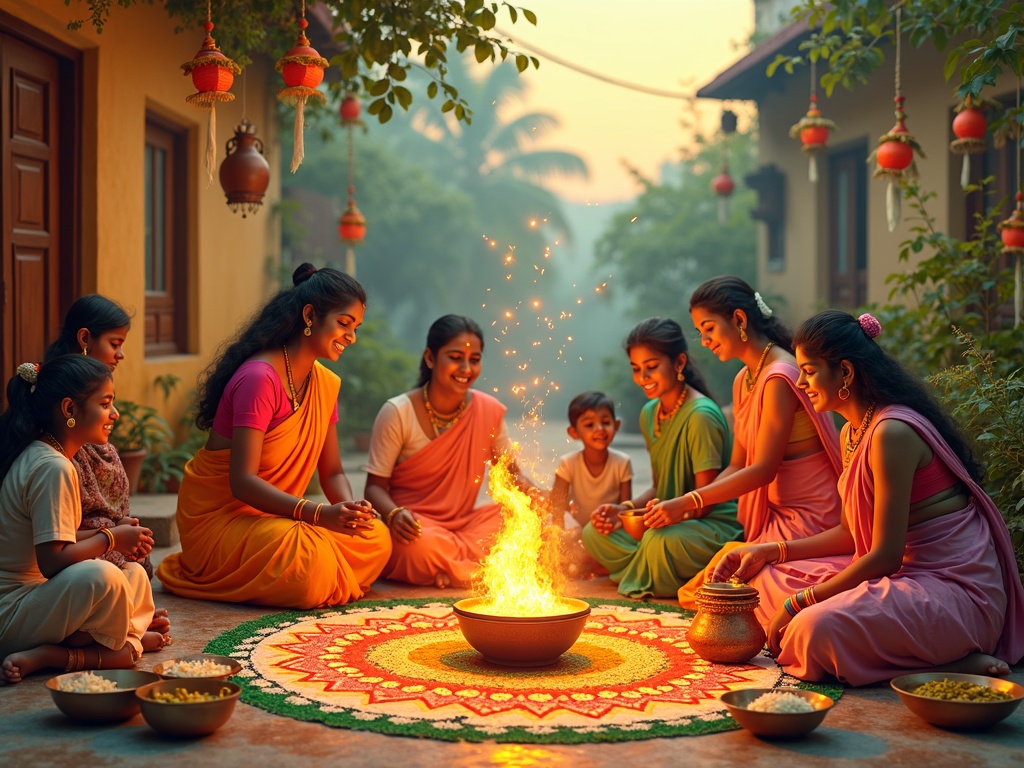Pongal recipe is a cherished traditional South Indian dish that sits at the heart of Tamil Nadu’s most significant harvest festival, celebrated over four days from January 14-17 each year. This sweet or savory rice preparation symbolizes abundance and prosperity, with the cooking process – specifically when it “overflows” – representing hopes for plenty in all aspects of life.
Find In This Article
Key Takeaways
- Pongal is cooked with essential ingredients including aged white rice, milk, jaggery, ghee, and cardamom, with cashews and coconut for texture and flavor.
- The traditional preparation method involves slow-cooking in a clay pot to develop authentic flavors and a creamy texture.
- Pongal is typically served hot with accompaniments like coconut chutney, sambar, vadai, pickle, and yogurt.
- During the Pongal festival, the dish is first offered as gratitude to nature and the sun god before being shared with family.
- Beyond its culinary significance, Pongal preserves Tamil cultural heritage by connecting generations through traditional cooking methods and communal celebrations.
The Sweet Tradition of Celebrating Pongal Festival
Pongal stands as one of the most significant harvest festivals celebrated across Tamil Nadu with immense fervor and devotion. This four-day celebration marks the end of winter solstice and the beginning of Uttarayanam, the sun’s northward journey. It’s fascinating to know that approximately 73% of Tamil Nadu’s population actively participates in these celebrations, making it a cornerstone of Tamil cultural identity.
The festival runs from January 14-17 each year, with each day holding special significance and customs. I’ve found that understanding these distinct days helps appreciate why Pongal dishes like khichdi are so central to the celebration.
The Four Sacred Days of Pongal
The festival unfolds across four meaningful days, each with unique rituals and significance:
- Bhogi: The first day marks new beginnings with house cleaning and discarding old possessions. Families gather around bonfires to burn unwanted items, symbolizing the removal of negativity.
- Thai Pongal: This central day honors the Sun God (Surya). Families cook fresh rice with milk in new clay pots until it overflows, shouting “Pongalo Pongal!” to celebrate abundance.
- Mattu Pongal: Dedicated to cattle, this day involves decorating cows and bulls with paint, flowers, and bells as a gesture of gratitude for their role in agriculture.
- Kaanum Pongal: The final day focuses on family gatherings and outings, strengthening community bonds.
The overflowing pot of sweet rice symbolizes prosperity and abundance – the very meaning of “Pongal” is “to boil over.” This tradition directly connects to the delicious rice preparations that feature prominently in the festival’s culinary celebrations.
Agricultural Significance and Sacred Rituals
At its heart, Pongal celebrates the intimate relationship between farmers, land, and the elements that sustain life. The central ritual involves worshiping agricultural tools and implements, acknowledging their crucial role in sustaining livelihoods.
Before cooking the traditional Pongal dish, families clean their homes thoroughly and draw elaborate kolam (rangoli) patterns with rice flour at their doorsteps. The cooking process itself becomes a sacred ritual – traditionally done outdoors in the morning sunlight using a new clay pot decorated with turmeric, ginger, and sugarcane.
The pot is placed on a small makeshift stove built with bricks, with the Sun God as the primary witness. When the mixture of rice, moong dal, jaggery, and milk boils over, it’s considered highly auspicious. Families then offer this sweet Pongal to the Sun God before sharing it among themselves.
I’ve noticed that these traditions vary slightly across different regions, but the essence remains the same – gratitude for nature’s bounty. Some families incorporate pulao and similar rice dishes into their festival menus alongside the traditional sweet and savory Pongal varieties.
For many Tamil families, Pongal represents not just a cultural celebration but also a time for reunion. The aromas of freshly cooked Pongal, the sight of decorated cattle, and homes adorned with mango leaves create an atmosphere of joy that transcends generations. Whether prepared traditionally or with modern adaptations, the Pongal dish remains the heart of this beautiful harvest festival, connecting people to their agricultural heritage and to each other.

Essential Ingredients for Perfect Pongal
Creating authentic Pongal requires carefully selected ingredients that blend together to create this beloved South Indian dish. I’ve found that using the right components makes all the difference between an ordinary rice dish and a memorable culinary experience.
Core Components and Variations
The foundation of perfect Pongal starts with 1 cup of aged uncooked white rice. Aged rice isn’t just a preference—it delivers a richer flavor and better texture than newly harvested varieties. For the cooking liquid, I combine 3 cups of water with 1 cup of milk, which creates a creamy consistency that’s characteristic of traditional Pongal.
Sweetness comes from 1 cup of organic jaggery, an unrefined cane sugar that adds both depth and complexity beyond what regular sugar can offer. The distinctive aroma and taste of Pongal largely depend on 4 tablespoons of ghee (clarified butter), which gives the dish its luxurious mouthfeel and authentic flavor profile.
For the perfect spice balance, I include 1 tablespoon of cardamom powder. This aromatic spice cuts through the richness and adds a fragrant element that makes Pongal uniquely flavorful compared to other rice dishes.
The textural contrast is equally important when preparing this traditional dish:
- A handful of cashews adds nutty crunch and richness
- Optional raisins provide bursts of natural sweetness
- Fresh coconut serves as the perfect garnish, adding tropical freshness
- For a heartier variation, adding lentils transforms the dish into a more protein-rich meal
When preparing Pongal for special occasions, I sometimes incorporate additional toppings or creative rice variations to elevate the dish. The beauty of Pongal lies in its adaptability while maintaining its core identity—making it perfect for both everyday meals and festive celebrations.
By keeping these essential ingredients on hand, you can create a Pongal that honors tradition while still allowing for personal touches that make the recipe your own.
Making Your Pongal the Traditional Way
I’ve found that preparing Pongal the traditional way brings out its authentic flavors and creates a dish that truly honors its South Indian heritage. The process starts with proper preparation of the rice, which forms the foundation of this beloved dish.
To begin, I wash the rice thoroughly until the water runs clear. This step is crucial as it removes excess starch and any impurities. After washing, I drain the rice completely before moving on to the cooking process.
The heart of traditional Pongal preparation lies in using the right cookware and ingredients. I combine the washed rice with water and milk in a traditional pot, preferably a clay pot if available, as it imparts a distinct earthy flavor to the wholesome rice preparation.
Once the ingredients are combined, I cook the mixture on low heat for about 30 minutes. During this time, I stir occasionally to prevent the rice from sticking to the bottom of the pot. This slow cooking method allows the rice to absorb the liquid gradually, resulting in a creamy texture that’s characteristic of perfect Pongal.
Adding Sweetness and Flavor
After the rice has cooked and softened, it’s time to enhance the Pongal with sweetness and aromatic flavors. I add jaggery, which gives the dish its signature sweetness and golden hue. Next comes ghee, adding richness and a nutty aroma that’s impossible to resist.
To elevate the flavor profile, I incorporate:
- Freshly ground cardamom powder for a sweet, floral note
- Fried cashews for a delightful crunch and nutty taste
- A pinch of saffron (optional) for color and subtle aroma
- A small amount of grated ginger for warmth and digestive benefits
After adding these ingredients, I continue cooking for another 5-10 minutes until everything is well blended. The aroma that fills the kitchen at this point is simply divine! The entire preparation process takes about 30-45 minutes from start to finish, and the recipe yields 4 generous servings.
The final texture should be creamy yet have individual rice grains visible – not too mushy or too firm. I’ve noticed that letting the Pongal rest for about 5 minutes after turning off the heat allows the flavors to meld together beautifully.
This traditional method of making Pongal results in a dish that’s not just food but a celebration of culture and heritage. It’s perfect for serving during festivals like Thai Pongal or as a comforting home-cooked meal any time of the year.
For those short on time, I sometimes prepare the rice in a pressure cooker first, then transfer it to a traditional pot for the final stages of adding the sweet and aromatic ingredients. While this cuts down on cooking time, I must admit the slow-cooked version has an edge in terms of texture and flavor development.
Whether you’re preparing Pongal for a special occasion or as a weekday treat, following these traditional methods will ensure you create an authentic dish that carries the true essence of South Indian culinary traditions.
Serving Your Festive Pongal
The final presentation of Pongal elevates this simple rice dish into a true celebration of harvest and thanksgiving. I’ve found that serving Pongal properly isn’t just about the food itself—it’s about creating an experience that honors tradition while bringing people together.
Pongal tastes best when served piping hot in traditional brass or earthen vessels. The warmth of the dish complements its hearty flavors perfectly. Before serving, I like to add a final touch of ghee on top, allowing it to create little pools that enhance both flavor and visual appeal. A sprinkle of freshly crushed black pepper and curry leaves fried in ghee makes for an aromatic finish that signals to everyone that the feast is ready.
Traditional Accompaniments and Presentation
No Pongal meal is complete without its classic accompaniments. These side dishes balance the meal and add contrasting flavors:
- Coconut chutney provides cooling freshness against the warmth of the Pongal
- Sambar offers tangy depth with vegetables and lentils
- Vadai (crispy lentil fritters) adds textural contrast
- A small serving of pickle brings concentrated flavor bursts
- Plain yogurt helps balance the richness of the dish
The beauty of Pongal’s comfort food qualities shines when it’s shared communally. During Pongal festival, I arrange the dining space to encourage conversation and togetherness. The central serving dish becomes the focal point around which stories are exchanged and blessings are offered.
In many South Indian homes, Pongal isn’t just served—it’s presented as an offering first. A small portion is placed aside as gratitude to nature and the sun god before the family partakes in the meal. This ritual acknowledges the agricultural bounty that makes the celebration possible.
The timing of serving matters too. Morning Pongal during the festival is particularly significant, representing the first rays of sun on harvest day. I find that setting the table with banana leaves (when available) or brass plates adds to the authentic feel of this celebration.
Children are often served first, followed by elders—a practice that respects both innocence and wisdom. Each person receives a generous portion of the creamy rice preparation, with the server ensuring that every plate has a perfect balance of rice, lentils, and seasoning.
What makes serving Pongal truly special is how it transforms ordinary mealtimes into moments of connection. Families gather across generations, neighbors visit with good wishes, and even strangers are welcomed to partake in this symbol of prosperity. I’ve noticed that something magical happens when people share this humble dish—conversation flows easily, laughter fills the room, and bonds strengthen.
The act of serving becomes a gift of nourishment and love. As hands reach for seconds and compliments flow to the cook, Pongal fulfills its purpose as more than just food—it becomes the reason for gathering, for celebrating life’s simple joys, and for carrying forward traditions that have sustained communities for centuries.
When you’re ready to serve your homemade rice dish, remember that presentation matters almost as much as taste. The genuine happiness that comes from sharing this special meal makes every minute of preparation worthwhile.

The Heart of Tamil Culture
Pongal represents far more than just a dish – it’s a vibrant symbol of Tamil heritage that connects generations through food. I’ve always been fascinated by how this simple rice dish carries such profound cultural significance, serving as a delicious link to ancient traditions that continue to thrive today.
A Celebration of Nature’s Bounty
Pongal embodies gratitude towards nature and agriculture in its purest form. The very act of cooking this dish celebrates the harvest season, with each ingredient honoring the earth’s gifts. The tradition involves cooking rice and lentils in a clay pot until they “overflow” – a symbolic representation of abundance and prosperity for the coming year. This overflowing pot tradition isn’t just visually striking; it carries deep meaning about hoping for plenty in all aspects of life.
When preparing traditional rice dishes like Pongal, I’m always reminded of how our ancestors acknowledged their dependence on natural cycles. The ritual of cooking outdoors, often using firewood, strengthens this connection to the elements. The ingredients themselves – rice, moong dal, ghee, and spices – are all agricultural products that sustain communities throughout the year.
Preserving Heritage Through Taste
Pongal serves as an essential vehicle for preserving cultural heritage in Tamil communities worldwide. Each family gathering centered around this dish becomes an opportunity to pass down not just recipes, but values, stories, and cooking techniques that might otherwise fade away.
I find particular value in how Pongal teaches younger generations traditional cooking methods. When elders demonstrate the proper way to prepare the dish – from washing the rice to tempering with cumin, pepper, and cashews – they’re transmitting practical knowledge that connects youth to their roots. These cooking lessons become informal classrooms for cultural education.
The preparation process emphasizes patience and attention to detail:
- Roasting moong dal to enhance flavor before cooking
- Achieving the perfect consistency – neither too dry nor too watery
- Mastering the art of tempering with ghee, cashews, and spices
- Learning to cook in traditional vessels that enhance flavor
Family gatherings during Pongal celebrations strengthen community bonds and reinforce shared identity. The communal aspect of preparing and enjoying the dish creates spaces for storytelling, sharing wisdom, and celebrating collective heritage. In many Tamil homes, rice-based dishes like Pongal become centerpieces for conversations that span generations.
I’ve observed how even Tamil families living far from their ancestral homeland maintain these traditions, adapting them to new environments while preserving their essence. The distinctive aroma of Pongal cooking in a household instantly transports people to their cultural roots, no matter where they may physically be.
Through this simple yet profound dish, Tamil culture continues to flourish across borders and generations. The act of preparing Pongal connects modern practitioners to ancient wisdom, serving as a delicious reminder that cultural heritage lives not just in museums or textbooks, but in everyday practices that nourish both body and spirit. When I prepare special rice recipes for celebrations, I’m participating in a cultural continuity that spans centuries.
Sources:
The Times of India, Pongal Festival: Harvest Festival of Tamil Nadu
BBC Good Food, Pongal Recipes & Cooking Tips
The Hindu, Importance of Pongal Festival in Tamil Culture

